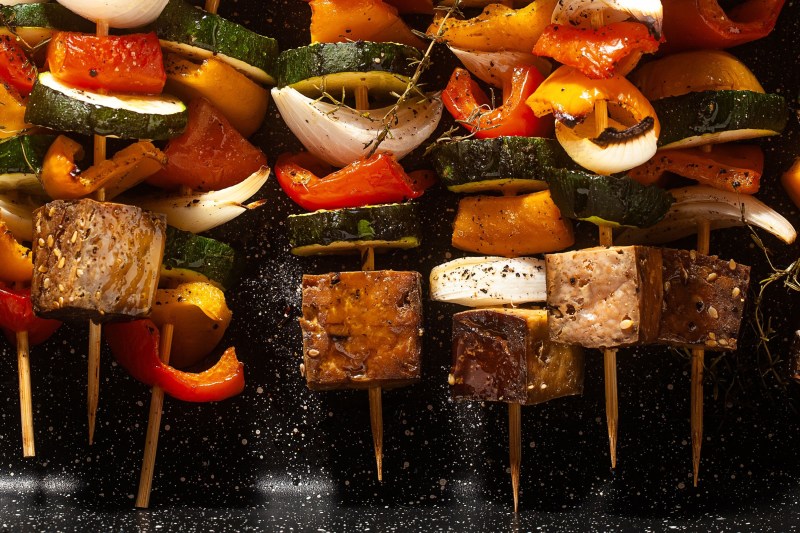
There’s something so fun about a kebab…or kabob…or kabab. No matter how you spell it, it’s food on a stick, and food on a stick is always a hoot. These grilled little treats are always a massive hit at barbecues for their obvious charm, delicious smokey flavor, and the incredible convenience of having an entire meal on one simple skewer. But in addition to their deliciousness and beauty, there are a few potential kebab pitfalls to be wary of before lighting up that grill. Here are a few tips and tricks that will help you grill perfect kebabs every single time.
Choose the right meats

First things first: always steer clear of the pre-cubed stuff they sell at the grocery store alongside the proper cuts. The time you save (about two minutes) is not worth the lackluster, sloppy scrap cuts you get in these packages – not to mention the added cost. Opt for whole pieces, and do the knife work yourself. It isn’t hard to cut meat into chunks.
When you do get out that knife and do the work yourself, those chunks of meat should be at least one inch thick. This will give the meat time to char beautifully on the outside while maintaining a tender, juicy center. Be mindful of cutting all of your pieces roughly the same size and shape to avoid uneven cooking.
No matter the meat you’ve selected for your kebabs, it’s best to go with darker, fattier cuts. Leaner meats will dry out quickly over the flames due to their lack of fat, so it’s important to choose meats with a little extra junk in the trunk. At the same time, overly fatty meats should be trimmed if the fat content is extreme.
Beef
Sirloin grills beautifully on skewers. Many sirloin cuts are already about an inch in thickness, beautifully savory, and have a great fatty-but-not-too-fatty heft to them. Simply cut into cubes, pop on the skewer, and you’re ready to go.
Chicken
Chicken thighs are the poultry of choice when it comes to grilled skewers. Granted, they’re not as easy as breasts to cut into uniform cubes for picture-perfect kebabs, but they sure do taste a hell of a lot better. The added fat in chicken thighs and legs will give your chicken kebabs a charred yet juicy and flavorful bite that’s absolutely delicious.
Pork
Pork may not be the first thing that comes to mind when you imagine grilled kebabss, but if you select the right cut, pork skewers are incredibly tasty. We suggest using pork butt for its added fattiness and savory flavor. Do be sure to trim away any gristle on your pork butt before cutting it into cubes.
Choose the right vegetables

Grilled vegetables are arguably the most underrated barbecue fare. Just about any ordinary humdrum vegetable turns to absolute magic after a smokey, firey makeover. The caramelization is almost sinful in its sweet and savory temptation, so get to grilling your produce immediately. Please and thank you.
Before you hit the produce section, you may be wondering which vegetables are best when grilled. The answer, plain and simple, is just about all of them. But if you’re looking to make a list, we absolutely love eggplant, bell peppers, Portobello mushrooms, asparagus, onions, zucchini, artichokes, radishes, and carrots – to name a few.
When grilling vegetables – just as with meats – be mindful of their size, shape, and textures. Not every vegetable will cook at the same time and temperature, so it’s important to group similarly sized ingredients together.
Know your skewers

While skewers have become quite fancy in recent years, some with gorgeous designs and shapes reminiscent of medieval weaponry, there are still only two basic kinds worthy of mention: wood and metal.
Wood skewers must be soaked in water before hitting the grill grates. This step is absolutely crucial to avoid a firey culinary catastrophe. Simply soak your wooden skewers in water for at least one hour prior to grilling, making sure that they’re completely submerged.
Metal skewers do not require soaking for obvious reasons, but that doesn’t necessarily make them a more low-maintenance option. In our experience, food can slip quite easily from rounded metal skewers, which makes moving these around on the grill rather tricky. If you prefer metal skewers, try to find some with a square or twisted shape to the rod to get a better grip on your food.
Give your kebabs space

While it may be more aesthetically pleasing to cram as many colorful shapes and sizes onto your skewers as possible with each ingredient pressed intimately into the next, try to avoid this rookie kebab move. In order to cook food properly, heat needs to have the ability to weave and flow over, under, and around an ingredient. If you want your kebabs to be evenly cooked and gorgeously charred, give a little wiggle room between each ingredient on your skewer. You can always push them together when they come off the heat.
In fact, some cooks insist on only cooking one ingredient per skewer, in the interest of even cooking. We understand that this takes a lot of the fun out of kebabs, so we won’t push this view, though it’s something to think about. We suggest simply skewering similarly sized and shaped ingredients together, but with a little wiggle room between ingredients.



